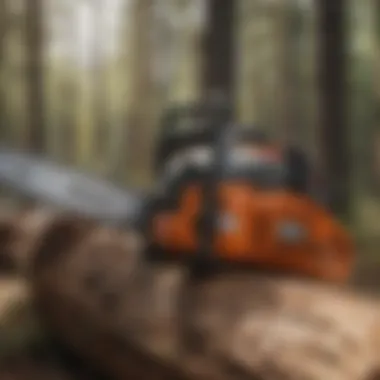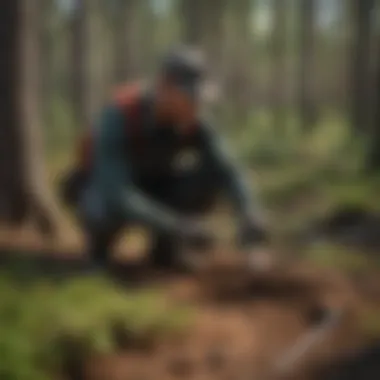Essential Red Pine Equipment for Forestry Management


Intro
Forestry management stands at the intersection of environmental stewardship and economic viability. Among the various tree species, red pine serves as a stalwart ally in this domain, providing both timber value and ecological benefits. As such, the right tools and equipment are indispensable for the effective management of red pine forests. A keen understanding of forestry practices, sustainable management principles, and woodland stewardship strategies is essential for those involved in this field.
Through this article, we will embark on a deep dive into essential tools and techniques tailored specifically for red pine ecosystems. We will unpack operational guidelines, detail necessary specifications, and explore best practices that not only sustain these vital woodlands but enhance their overall health and resilience.
With the global push towards sustainability gaining momentum, this investigation into red pine management goes beyond mere equipment selection. It also illuminates the broader societal and ecological impacts of well-informed forestry practices. Join us as we unravel the intricacies of managing red pine landscapes, where each tool in hand plays a pivotal role in preserving these majestic forests for future generations.
Understanding Red Pine Ecology
Understanding the ecology of red pine is crucial for effective forestry management. This knowledge provides the foundation for selecting the right tools and practices that align with the unique characteristics of red pine ecosystems. Recognizing these dynamics helps in fostering healthy growth and sustainability within these forests.
Characteristics of Red Pine
Red pine, scientifically known as Pinus resinosa, displays distinctive features that set it apart from other conifer species. It is renowned for its tall, straight trunk, typically reaching heights of 80 to 100 feet. The bark is thick and reddish-brown, often flaking off in irregular plates. The long, slender needles grow in bundles of two, creating a lush canopy that allows light to filter through while providing habitat for various wildlife.
When it comes to growth patterns, red pines are quite resilient. They have a relatively fast growth rate, particularly in their youth, and prefer well-drained, sandy soils. Such adaptability makes them an ideal choice for reforestation efforts, especially in areas where other species might struggle. Moreover, the wood of red pine is valued for its strength and versatility in construction and furniture making.
Distribution and Habitat Preferences
Red pine is predominantly found in the northeastern United States, extending into southeastern Canada. It thrives in regions characterized by cold winters and warm summers, preferring areas with low to moderate humidity. This tree species favors well-drained soils, often taking root in sandy or gravelly hilltops and plateaus.
Interestingly, red pine forests usually grow alongside other species such as oak, hickory, and birch, creating a diverse ecosystem. Each tree contributes to the overall health of the forest, influencing soil quality and providing shelter for various wildlife. Adapting forestry practices to the specific habitat preferences of red pine not only ensures sustainable management but also enhances the biodiversity of the area.
Environmental Benefits of Red Pine
Beyond its timber value, red pine offers substantial environmental benefits. One of its primary contributions is carbon sequestration. These trees absorb carbon dioxide from the atmosphere, thus playing a role in mitigating climate change. When managed correctly, red pine forests can store significant amounts of carbon over their lifespan.
Another crucial benefit is soil stabilization. The root systems of red pines help prevent soil erosion, especially in sloped areas. This quality is particularly significant in preventing landslides and maintaining water quality in surrounding watersheds. Moreover, red pine forests promote habitat restoration by supporting various wildlife species that rely on its ecosystem for nourishment and shelter.
In summary, understanding red pine ecology is not just about identifying trees and their habitats, but rather appreciating the complex interplay between these natural systems and the human activities that can either enhance or diminish them. Identifying the appropriate equipment and practices for managing red pine is deeply rooted in this ecological understanding.
Importance of Specialized Equipment
Specialized equipment plays a pivotal role in the realm of red pine forestry management. As the landscape of forestry evolves and as sustainability becomes a priority, having the right tools isn't just nice to have; it’s essential. Specialized equipment ensures that tasks can be executed efficiently while minimizing damage to the delicate ecosystems typical of red pine forests. When we think about red pine management, the specifics of equipment used not only determine the success of harvesting and maintenance practices, but also influence the overall health of the forest itself.
Role of Equipment in Red Pine Forestry
Every forestry operation benefits from tools tailored for the task at hand. In red pine forestry, using the wrong equipment can lead to inefficiencies and even ecological harm. Specialized tools are designed to tackle the unique challenges that come with this type of management. For instance, planting tools help ensure optimal spacing and depth for saplings, increasing their chances of survival. This is especially vital for red pines since they have particular soil and environmental preferences.
Moreover, harvesting machinery equipped with advanced technologies makes it possible to extract timber sustainably. High-tech harvesters can precisely measure and assess tree sizes, allowing for selective logging that reduces waste and promotes regeneration. This method keeps the forest floor intact, benefiting not just the trees but the entire ecosystem of plants and animals that call it home.
In essence, when equipment is designed with the ecosystem in mind, the balance between productivity and environmental conservation becomes more achievable.
Adaptation to Ecosystems
The adaptability of forestry tools to specific ecosystems is another argument in favor of using specialized equipment. Red pine ecosystems can be quite diverse, with different subtypes of soil and microclimates affecting growth and health. Equipment designed for this environment often address these variances directly.
For example, soil cultivation tools can be adjusted for varying soil textures that characterize red pine forests. Some machinery may have interchangeable settings to suit sandy soils versus clay-rich terrains. This level of specificity fosters healthier pine trees, which in turn supports a thriving ecosystem.
Additionally, tools that increase aeration or enhance drainage at planting sites can address water retention issues, safeguarding saplings against the risk of rot or stress. Ecosystems are not static; they can change with seasons and human interaction. Therefore, having tools that can quickly adapt to these changes is paramount.
"The effectiveness of our forestry practices hinges on the tools we wield; in specialized equipment, we find the bridge between human activity and ecological responsibility."
In summary, the importance of specialized equipment in red pine forestry cannot be overstated. It not only streamlines operations but also fosters a healthier environment time and again. Understanding these aspects gives forestry professionals valuable insights into their own practices and the equipment they choose to adopt.
Categories of Red Pine Equipment


The successful management of red pine forests hinges not only on understanding the ecological nuances but also on having the right tools at one’s disposal. Various categories of equipment are essential, each serving distinct purposes that collectively ensure the health, sustainability, and productivity of these valued ecosystems. Whether it’s about planting young saplings, maintaining the health of mature trees, or efficiently harvesting timber, a well-defined array of equipment tailored for each stage of the forestry process is crucial. Investing in specialized tools translates to increased efficiency and reduced environmental impact, shaping the future of red pine forestry.
Planting and Establishment Tools
Planting and establishment tools form the backbone of initial forestry operations. These tools are designed to facilitate the successful transplantation of red pine saplings into their new environment, ensuring that they take root in optimal conditions.
- Seedling Transplanters: This equipment helps in planting seedlings at the correct depth and spacing, essential for nurturing healthy growth. Efficiency and precision are key here, as every sapling’s placement affects its chances of survival.
- Hand Tools: Simple tools like shovels, hoes, and spades may seem rudimentary, yet they play a pivotal role during the initial planting phase. Familiarity with these tools allows workers to adapt to varying soil conditions—heavy clay versus sandy loam, for example.
The right planting tools not only simplify the establishment process but also enhance the long-term growth potential of red pine forests.
Maintenance Equipment
Maintaining the health of red pine forests is an ongoing task. Proper maintenance equipment ensures that these ecosystems thrive amidst competing vegetation, pests, and diseases.
- Chainsaws: These are indispensable for thinning crowded stands and removing dead or diseased trees. Proper use of chainsaws, ensuring they are well-maintained and appropriately sized, can significantly influence the forest’s overall health.
- Brush Cutters: These are specialized tools for managing underbrush, a vital aspect of forest health. By keeping competing plant species in check, brush cutters contribute to the growth of red pine communities, allowing them to dominate their habitats.
- Fertilizers and Spreaders: Nutrient application is vital, especially in areas where soil health is degraded. Understanding the appropriate fertilizers and how to apply them through the right spreaders can significantly enhance tree growth and vigor.
Investing time and resources into maintaining equipment ensures its efficiency and effectiveness, ultimately protecting the red pine's habitat and health.
Harvesting Machinery
When it comes to harvesting red pine, having the right machinery is a game-changer. Efficiency, safety, and ensuring minimal impact on the surrounding ecosystem are paramount considerations in the selection of harvesting equipment.
- Feller Bunchers: These machines combine the talents of cutting and stacking trees. They not only enhance efficiency but also reduce the physical strain on human labor. Careful operation is necessary to prevent damage to the remaining trees and soil.
- Forwarders: Transporting harvested logs can be a challenging task. Forwarders are designed for moving logs from the forest to loading areas, helping limit ground disturbance and soil compaction during timber extraction.
- Skidders: They are used for moving cut logs to a landing. With the right adjustments, skidders operate with fuel efficiency, ensuring the process is not only productive but also environmentally friendly.
The strategic use of harvesting machinery can lead to successful implementations while mitigating potential challenges.
Transportation and Logistics Tools
After completion of the harvesting phase, proper transportation mechanisms become essential. Tools in this category must ensure quick, safe, and economical movement of timber from forest to market.
- Trucks and Trailers: Specialized trucks fitted with trailers designed for transporting logs can greatly enhance operational efficiency. Variations like low-bed trailers offer stability and ease of loading.
- GPS and Mapping Tools: Utilizing technology in the transportation phase aids in planning routes, ensuring that timber reaches its destination in a timely manner while minimizing costs.
- Loading Equipment: Forklifts or cranes that are proficient in handling heavy logs can facilitate streamlined loading at mill operations, providing both time and effort savings.
A thorough understanding of transportation and logistics tools helps ensure that red pine forestry operations run smoothly from harvest to distribution, maintaining the health of surrounding areas throughout the process.
Key Equipment Specifications
Understanding the specifications of equipment used in forestry management is not just a matter of technical detail. It's about enhancing efficacy in the cultivation and preservation of vital ecosystems like those dominated by red pine trees. The right specifications can make the difference between optimum growth and inefficient management. These specifications often reflect the operational needs and constraints specific to red pine forestry. Knowing what to look for helps professionals make informed choices about equipment that not only is effective but aligned with sustainability practices.
Essential Features for Effectiveness
When it comes to forestry equipment, several features stand out as crucial for maximizing effectiveness:
- Durability: Given the rugged conditions of forested areas, equipment must be built to withstand harsh weather and rough terrains. For example, the chainsaw or chippers made with high-grade steel can resist wear and tear over time, leading to less downtime for repairs.
- Versatility: Tools that serve multiple purposes can save both time and money. A piece of equipment that can be adjusted or adapted to different tasks is invaluable. Think of a multi-tool that can dig, prune, or even cut branches as needed.
- Efficiency: Fuel consumption and energy use are key considerations. Equipment that offers high output with low input not only is cost-effective but also lowers the carbon footprint. For instance, eco-friendly models of forestry equipment might use Bio-diesel, which can have a lesser impact on the environment.
- Ease of Use: User-friendly interfaces and ergonomics can markedly increase productivity. Equipment designed with operators in mind promotes safety and minimizes strain, particularly during long shifts in the woods.
Equipped with these capabilities, professionals can ensure that they are not just working hard, but also working smart.
Safety Considerations
While functionality is essential, safety must never be sidelined when choosing forestry equipment. Mishaps in the field can lead to severe injuries, and having equipment with good safety features can mitigate risks. Key safety considerations include:
- Protective Features: Equipment that comes with guards or shields can protect operators from debris and other hazardous materials. A chainsaw with an automatic brake, for example, can significantly reduce the risk of accidents.
- Stability: Machinery like forestry cranes should have features to prevent tipping. Stability ratings should be reviewed before making a purchase.
- Communication Systems: Many modern pieces of equipment incorporate alarms or communication systems. These alerts can warn operators about potential malfunctions or dangers in real time.
- Training Programs: Ensuring team members are adequately trained on the equipment being used can dramatically affect safety. A well-informed operator can identify risks and take proactive measures before disaster strikes.
"The key to effective forestry management isn’t just about the tools, but how safely and efficiently they are used."
In summation, ensuring equipment possesses the right specifications is critical for the success of red pine forestry work. Not only does it facilitate effective management practices, but it also safeguards against potential hazards in the field, allowing professionals to concentrate on what really matters: nurturing and protecting these vital ecosystems.
Operational Practices


The discussion of operational practices in the context of red pine forestry management is both foundational and transformative. These practices serve as the guiding principles that ensure efficiency, safety, and sustainability in the upkeep of red pine ecosystems. Without a well-defined operational framework, the risks associated with equipment use and environmental impact can escalate dramatically. Essentially, operational practices are the threads that weave together the effectiveness of equipment usage and the longevity of forestry management recovery efforts.
Best Practices for Equipment Use
Utilizing equipment effectively isn’t just about knowing how it works. It’s about understanding the forest, the tools, and the methods in concert. Adopting best practices can significantly enhance the operation of each piece of equipment. Here are some key guidelines:
- Training and Familiarity: Every operator should undergo thorough training. Knowing the specifications and capabilities of tools like skid steers or tree planters can prevent accidents and optimize performance. An operator who understands the quirks of their machinery can respond swiftly to issues.
- Pre-Use Checks: Conducting equipment checks before use is vital. Inspecting fluids, brakes, and any potential wear and tear ensures that everything runs smoothly. This practice prevents minute problems from ballooning into considerable setbacks later.
- Appropriate Usage: Using equipment in its intended capacity is crucial. For instance, overloading a logging truck may seem like a way to save time, but it could lead to severe breakdowns and accidents.
- Communication: Working collaboratively in forestry requires open lines of communication. Be it hand signals or radio calls, clear communication can prevent worksite mishaps and make operations more covert.
These practices create a safety net that allows professionals to focus on their core tasks while minimizing risk.
Maintenance Routines
Routine maintenance is, without a doubt, the backbone of effective equipment operation. Regular upkeep not only extends the lifespan of machinery but also directly impacts productivity levels in forestry operations. A well-maintained piece of equipment is more reliable and efficient, which translates to considerable savings over time. Here are some essential maintenance routines to keep in mind:
- Daily Checks: Simple inspections should be part of the daily routine. Checking oil levels, tire conditions, and hydraulic systems can flag issues before they escalate.
- Scheduled Servicing: Following the manufacturer's recommendations for service intervals is essential. Mechanical greasing, replacing filters, and checking fuel lines should happen as outlined in equipment manuals.
- Cleaning: Dirt and debris can quickly degrade equipment efficiency. Keeping machinery clean, particularly the cooling systems, can prevent overheating and preserve functionality.
- Record Keeping: Maintain a log of maintenance activities and repairs. This practice not only aids in warranty claims but can also highlight recurring issues that may need addressing.
Effective maintenance isn’t just about fixing problems; it’s about preventing them from arising in the first place. Having a clearly structured maintenance schedule allows for a proactive approach to machinery health, ensuring that operations run seamlessly and efficiently.
Altogether, these operational practices build a framework that reassures forestry professionals they are equipped for success. Consistent application of these principles ensures not just the well-being of the equipment but also the health of the entire red pine ecosystem.
Sustainability and Equipment Efficiency
In forestry management, the intersection of sustainability and equipment efficiency is paramount for cultivating thriving red pine ecosystems. These two aspects are intertwined in ways that not only foster healthier forests but also promote long-term viability for forestry operations. Sustainability involves utilizing resources in a manner that does not compromise future generations’ ability to meet their own needs. Meanwhile, equipment efficiency relates to maximizing performance while minimizing resource consumption and waste. Together, they create a framework within which forestry practices can flourish without detriment to the environment.
Minimizing Environmental Impact
Minimizing environmental impact is an ongoing concern in forestry management. Employing specialized equipment adapted for red pine involves choosing tools that are less intrusive to the ecosystem. For example, when selecting machinery for harvesting, opting for lighter models with smaller footprints can help reduce soil compaction and damage to surrounding vegetation.
Using equipment that adheres to environmental regulations ensures that operations align with best practices. Incorporating techniques like precision forestry—leveraging technology such as GPS and remote sensing—allows for efficient resource management, thereby preventing unnecessary over-extraction:
- Selective logging methods help preserve the undergrowth by removing only mature trees, allowing young pines to flourish.
- Integrated pest management technology can also minimize pesticide usage, protecting beneficial species and maintaining ecological balance.
- Mulching equipment aids in returning nutrients to the soil while reducing the need for chemical fertilizers.
"Sustainable practices not only protect ecosystems but armed foresters with the means to enhance productivity while respecting nature."
Cost-Effectiveness of Sustainable Equipment
Adopting sustainable equipment often proves to be financially prudent in the long run. On the surface, initial investments may seem hefty; however, the savings accrued from lower operational costs tend to offset these expenses. Sustainable machinery tends to be more fuel-efficient, significantly reducing fuel expenditures. Consequently, when machinery requires less fuel, greenhouse gas emissions decline, aligning with regulatory demands and public expectations.
Some cost-effective sustainable practices include:
- Investing in multifunctional equipment: Those that can perform several tasks cut down on the need for multiple tools, saving on maintenance and storage costs.
- Prioritizing equipment longevity: Machines built for durability often have a higher upfront cost but require fewer replacements over time, providing tangible returns on investment.
- Engaging in equipment sharing models within cooperative groups, which mitigates individual costs while promoting community stewardship.
Investing in the right tools and practices will ultimately enhance the productivity of forestry efforts by supporting the maintenance of healthy red pine ecosystems. Thus, balancing efficiency with sustainable practices turns out to be a win-win situation.
Advancements in Red Pine Equipment
In an ever-evolving field like forestry management, staying updated with advancements in red pine equipment is not just a luxury but a necessity. As technology continues to progress, the tools and machinery designed specifically for red pine management are becoming increasingly efficient, effective, and user-friendly. Understanding these advancements allows forestry professionals to make informed decisions that optimize their operations while also promoting sustainability.
Technological Innovations
One area of focus in advancements of red pine equipment is the integration of technological innovations. Today, equipment like automated planting machines and drone technology are revolutionizing the industry. These innovations streamline processes that once took days into mere hours.
- Automated Planting Machines: These machines enhance the accuracy of planting while minimizing labor costs. They efficiently place seedlings at the right depth and spacing, crucial for healthy forest growth.
- Drones for Monitoring: Using drones allows for thorough aerial assessments of forest health, spotting diseases or infestations early on. Thus, timely interventions can save countless trees and substantial costs.
Additionally, GPS technology plays a significant role in planning and executing forestry operations. Mapping out areas for harvesting or replanting can lead to a more organized approach, cutting down on wasted resources and time.
Future Trends in Forestry Equipment


Looking ahead, several key trends in forestry equipment for red pine management are expected to shape the industry. Here are some notable areas to consider:
- Increased Use of Biodegradable Materials: With a strong push for sustainability, equipment made from biodegradable components may become commonplace, reducing waste and environmental footprint.
- Smart Equipment: The rise of IoT (Internet of Things) means that equipment may become interconnected. This capability can track usage data and maintenance needs, helping to prolong the lifespan and performance of machinery.
- Focus on Carbon Capture: Future equipment will likely integrate technologies aimed at enhancing carbon capture rates in forests. This transition not only addresses climate concerns but also plays into regulatory and funding avenues for forestry professionals.
In essence, the trajectory of advancements in red pine equipment hinges significantly on technological integration, sustainability, and data-driven decision-making. Understanding these shifts can empower forest managers to not only preserve red pine ecosystems but thriving communities around them.
In summary, keeping an eye on the latest technological innovations and emerging trends will enable forestry professionals to adapt and thrive. As tools become more specialized and efficient, the possibilities for sustainable forest management expand, paving the way for healthier ecosystems.
Resources for Forestry Professionals
Understanding the ancillary resources available to forestry professionals is key in managing red pine ecosystems effectively. These resources span beyond just equipment, incorporating essential skills development and solid supplier relationships. In the rapidly changing field of forestry, continuous learning and access to the right tools and materials are fundamental for successful operations.
When it comes to red pine management, professionals can greatly benefit from structured training and development programs. These programs offer specialized learning opportunities that cover diverse topics—from understanding red pine ecology to mastering the latest tools for planting and harvesting. Participating in hands-on workshops or online courses can sharpen skills and ensure the workforce is well-equipped with the knowledge needed to address contemporary challenges in forestry.
But it doesn't stop there. Having a reliable network of equipment suppliers and manufacturers plays a vital role as well. This means not only understanding which products are available but also forming relationships that can lead to favorable arrangements for equipment purchases, repairs, and maintenance. Working with reputable suppliers ensures access to high-quality gear, which can help in reducing downtime and enhancing productivity.
"One's network is their net worth; this holds true in forestry too. Strong supplier relationships can make a significant difference."
In sum, from upgrading technical skills through educational programs to fostering solid partnerships with suppliers, these resources significantly bolster one's capacity to manage red pine forests. Not only do they aid in developing expertise, they also ensure that professionals are equipped with the best tools to navigate the complexities of forestry management.
Case Studies and Practical Applications
In the realm of forestry management, especially when dealing with red pine ecosystems, case studies and practical applications play a pivotal role. They serve as a bridge between theory and practice, providing real-world insights into the use of specialized equipment and the management of these forests. Understanding the successes and challenges faced by others in the field can guide forestry professionals in making informed decisions and adopting best practices.
Successful Implementations
Examining successful implementations sheds light on how various tools and equipment can be maximally utilized. For instance, in one notable case within the humid temperate forests of the northeastern United States, a forestry team adopted advanced planting and maintenance equipment designed explicitly for red pine. This included an array of automated seeders and precision forestry tools that enhanced planting efficiency and accuracy.
- A case study from Pennsylvania highlighted the use of the Vermeer 505N Baler for effectively managing slash from red pine thinnings. This equipment not only minimized waste but also provided a potential revenue source for excess biomass.
- Additionally, a project documented in Maine demonstrated the impact of using drone technology for monitoring forest health, enabling forestry managers to gather precise data on tree growth and soil conditions.
These successful implementations reflect the critical link between proper equipment and the achievement of sustainable forestry objectives, contributing to both environmental health and economic viability.
Learning from Challenges
While success stories offer valuable lessons, understanding the challenges faced during implementation provides an equally important framework for improvement. Missteps can offer cautionary tales that inform better future practices.
- One particular challenge noted in Oregon involved equipment failures due to unsuitable terrain for heavy machinery. This resulted in delays and increased operational costs, prompting a reevaluation of equipment choices best suited for red pine forest environments. In response, they transitioned to lighter, more adaptable machinery that could navigate the rugged landscapes more effectively.
- Another instance occurred in a Michigan case where the lack of proper training in equipment operation led to injuries and inefficiencies. Subsequent changes in training programs and the introduction of safety measures significantly improved not only operational efficiency but also worker safety.
The challenges faced during experiences with red pine forestry not only enhance understanding but also facilitate innovation in practices and the adaptation of equipment and strategies, ultimately leading to better resource management.
"Mistakes are proof that you are trying."
Careful analysis of these case studies, both successful and challenging, equips forestry professionals with the understanding necessary to navigate the complexities of red pine management intelligently. By learning from others, they can avoid common pitfalls, optimize their operations, and advance the goal of sustainability in forestry.
End: The Future of Red Pine Equipment
The discourse around red pine equipment is crucial, especially as we navigate the challenges posed by climate change and the increasing need for sustainable forestry practices. This article has illustrated how essential tools not only facilitate the management of red pine ecosystems but also contribute to the broader vision of ecological stewardship. With each new advancement in forestry equipment, we move closer to a balance that respects nature while meeting human demands.
Summary of Insights
In our exploration of red pine management tools, a few key points arise:
- Versatility in Equipment: The variety of tools—from planting gear to maintenance machinery—ensures that forestry professionals can adapt their approaches based on specific needs and environmental conditions. This adaptability is fundamental in maximizing the health and productivity of red pine forests.
- Technological Advancements: Innovations like GPS-enabled machinery and automated planting systems have revolutionized operational practices. This has not only increased efficiency but also reduced the physical toll on workers, showing positive movement toward worker safety and environmental impact.
- Emphasis on Sustainability: Sustainability isn't simply a trend; it's an essential part of forestry now. Equipments designed with eco-friendly materials and practices help ensure that our practices today do not compromise the forest for future generations.
"Investing in the right equipment is investing in the longevity of our forests".
Final Thoughts on Sustainability
When pondering the future of red pine equipment, sustainability must remain front and center. Forestry professionals face the ever-growing pressure of balancing ecological integrity with economic demands. Thus, choosing the right tools and techniques becomes not just a matter of efficiency, but of ethics and responsibility as well.
Moving forward, we need to continue to foster a culture of innovation that prioritizes eco-friendly practices. This includes rethinking existing equipment designs and investing in research to develop new technologies that enhance forest health.
By committing to sustainable practices—such as regularly servicing tools to reduce waste and choosing energy-efficient machines—we can ensure that our forestry operations proactively contribute to the health of red pine ecosystems. The choices made today will echo throughout future generations, affecting not only the landscape but the very essence of our relationship with nature.







